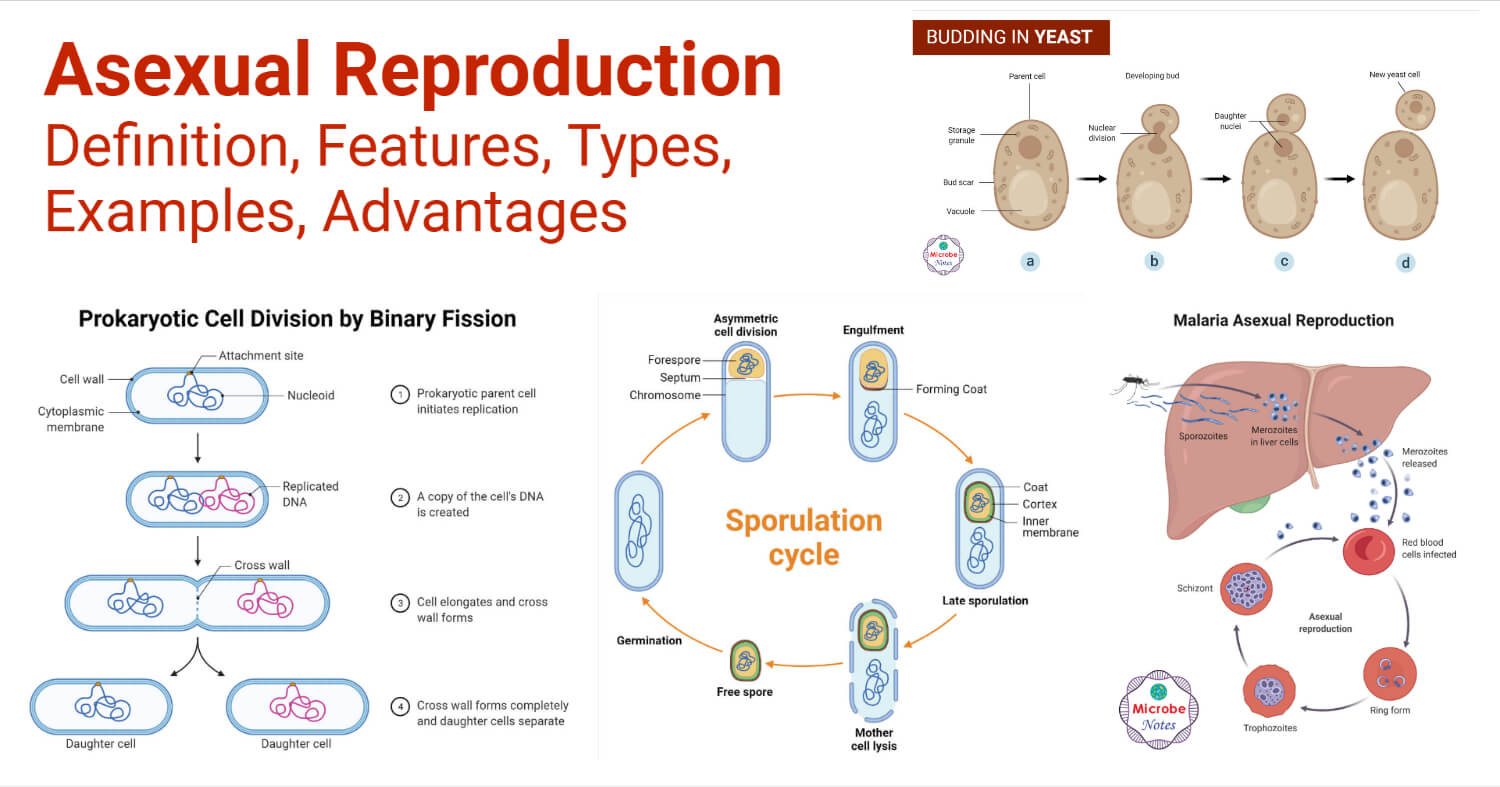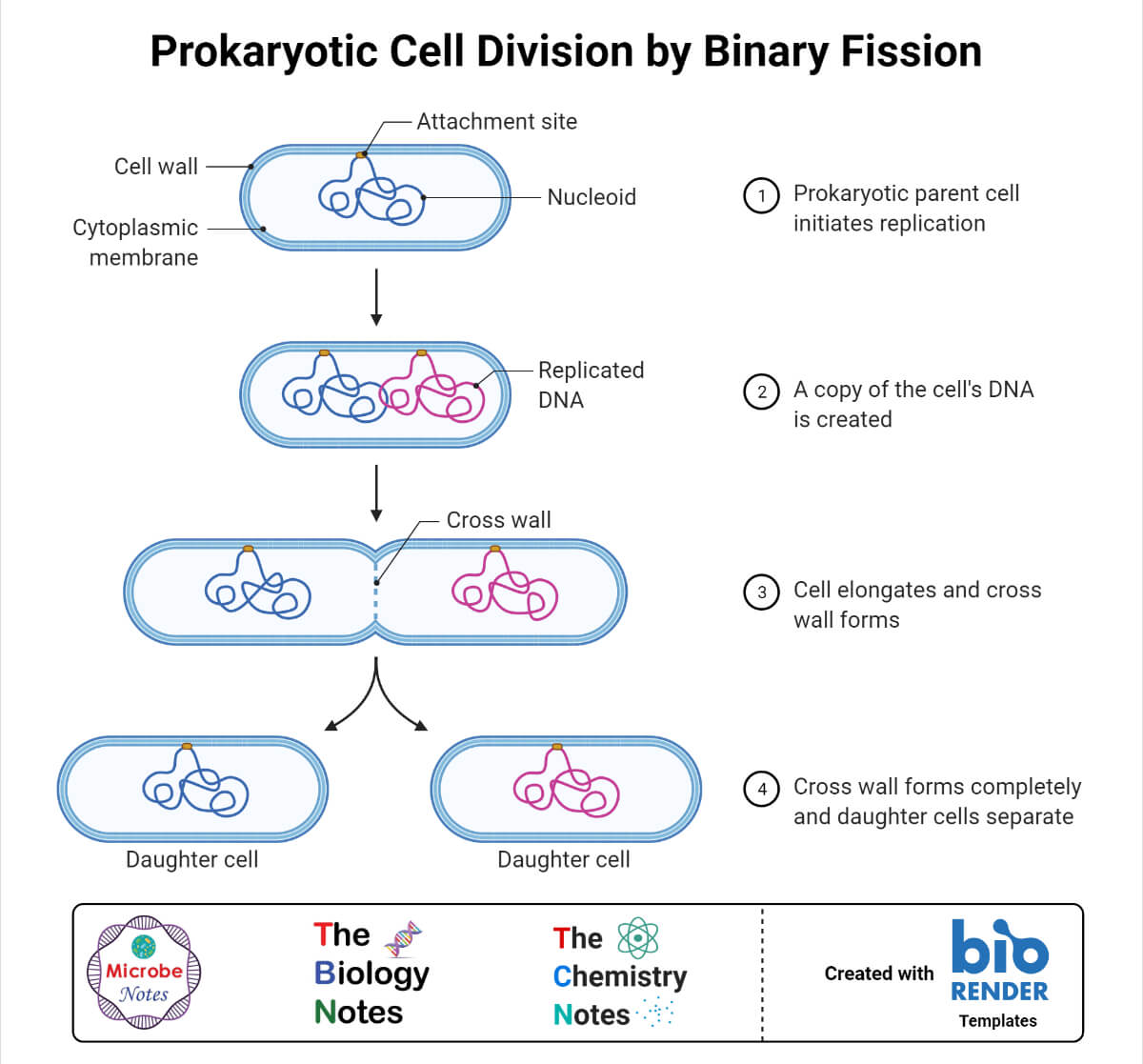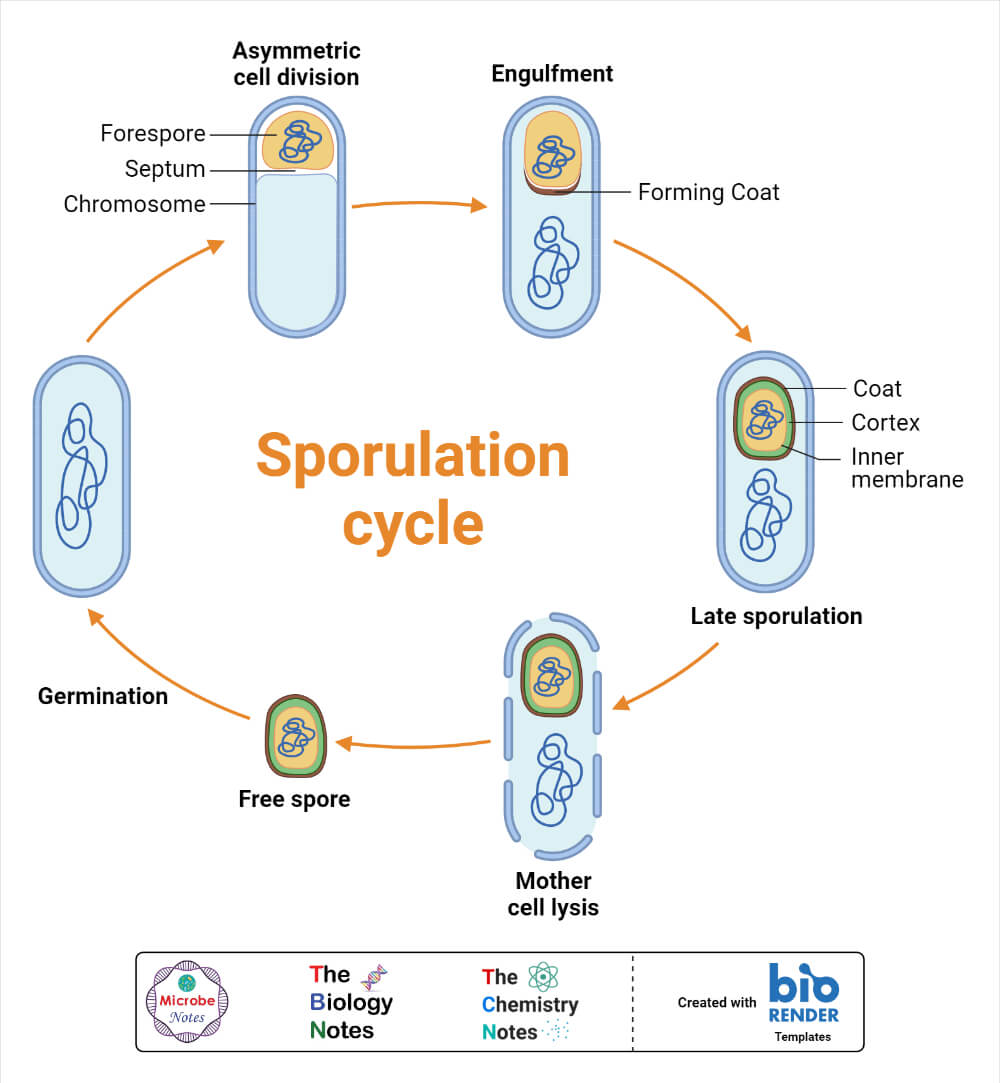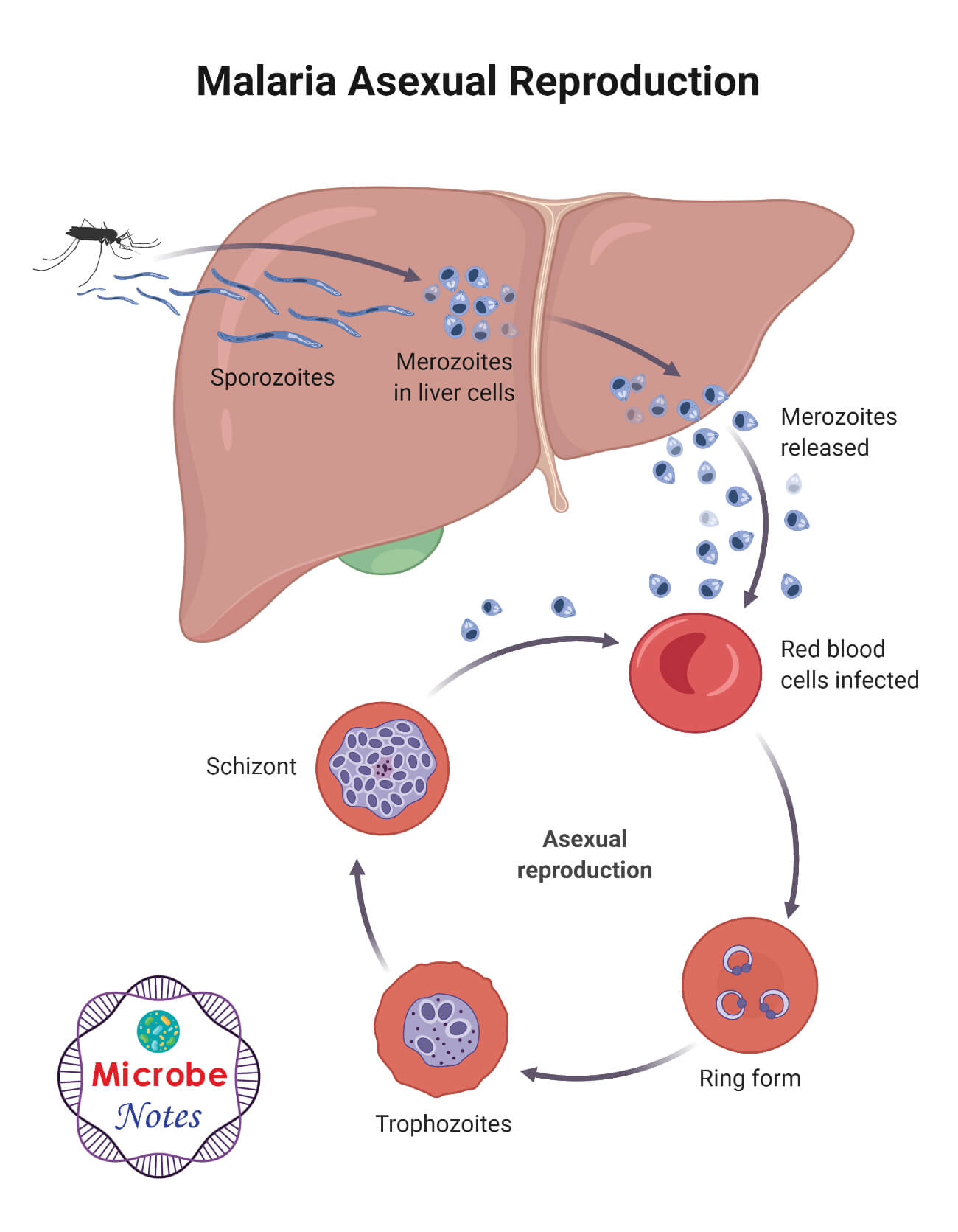Reproduction is a biological process of producing offspring of a living organism. It is the basis for continuing life from generation to generation. It is seen in every living organism; from microorganisms to larger organisms including all plants and animals. Based on the number of parents involved, and the formation and fusion of gametes, there are two types of reproduction; sexual reproduction and asexual reproduction.

Interesting Science Videos
What is Asexual Reproduction?
Asexual reproduction is the type of reproduction where offspring are produced without the fusion of male and female gametes. It is a reproduction process where only one individual makes its progeny without exchanging genetic material with another individual. Generally, it is considered a primitive mode of reproduction and usually occurs in microorganisms, including bacteria, fungi, and protozoa. All of the plants also have the capacity to asexually reproduce. However, only a few plants follow it as a sole mode of reproduction, and others usually show a sexual mode. In the kingdom Animalia, only a few invertebrates show asexual reproduction.
Asexual Reproduction Features
- There is no formation and fusion of male and female gametes. Hence, no male and female are required.
- Only a single parent is involved in the process.
- There is no exchange in genetic material, hence genetically all the offspring are identical to their parent.
- There is no chance of variation. Only some mutations may lead to evolutionary changes. Hence, evolutionarily, asexual reproduction is of no importance.
- The generation time is usually short, and the process occurs in very less time with minimum expense of cellular energy.
- Offspring mature very quickly and rapidly increase their population.
- It is usually seen in unicellular organisms. Only a few invertebrates and plants also follow this mode of reproduction.
- Influenced comparatively more than in sexual reproduction by the environmental conditions and nutrition.
Asexual Reproduction Types
Based on the mode of producing offspring, asexual reproduction is classified into several types, viz.:
A. Fission
Fission simply means division. It is a mode of asexual reproduction where unicellular organisms divide into two or more individuals. It is the most primitive and simple mode of reproduction, shown by unicellular organisms only like bacteria and protozoa. Here the genetic material (nucleus) splits into two or more parts. Then the cytoplasm also divides and new daughter cells are formed; each daughter cell with one nucleus. Depending upon the number of daughter cells produced from fission, it is further classified as binary fission and multiple fission.
1. Binary Fission
It is the process of asexual reproduction where a single individual divides into two new individuals (daughter cells). Here, first, the DNA (nucleus) is replicated and divided into two, followed by the division of cytoplasm leading to the formation of two daughter cells. It is seen in bacteria, archaebacteria, and protozoa like Amoeba, Leishmania, Plasmodium, Paramecium, etc.
It is further classified as simple binary fission, longitudinal binary fission, transverse binary fission, and oblique binary fission.

2. Multiple Fission
It is the process of asexual reproduction where a single individual divides into more than two individuals at the same time. In this process, first, the DNA (nucleus) duplicates into several copies (nuclei) (more than two), and each copy (nucleus) is surrounded by cytoplasm leading to the formation of multiple daughter cells. It is seen in some protozoa like Entamoeba, Plasmodium, etc. some Myxomycetes, and some algae (Siphonales, Acetabularia, etc.).
B. Budding
It is a type of asexual reproduction where an outgrowth on the surface of the parent’s body is specialized and separated and developed into a new individual. It is also called “blastogenesis”. In this process, a mature parent produces an outgrowth called ‘bud’. This bud will detach and grow as a new individual (daughter organism). It is seen in unicellular organisms like yeasts and fungi, certain protozoa, and some bacteria, and multicellular organisms like cnidarians (Hydra), jellyfish, flatworms, sea anemones, corals, plants, etc. Budding is further classified as internal and external budding.
1. Internal Budding (Endodyogeny)
It is the process where two daughter cells are produced within a mother cell, which is then consumed by the daughter cells before their separation. It is usually seen in parasites like Toxoplasma, Frenkelia, etc.
2. External Budding (Exodyogeny)
In this type, an external outgrowth develops on the surface of a parent organism which will detach on maturation and develop into a new individual. It is seen in yeasts, Hydra, sea anemones, etc.

C. Fragmentation
It is a type of asexual reproduction where the body of a mature organism is broken into several fragments, and each fragment will then subsequently grow into a new complete organism. It is a natural process but usually occurs as a result of some damage to a parent’s body. It is seen in some multicellular animals (like; starfish, Planaria, annelids including polychaetes and oligochaetes, turbellarians, etc.) and plants (like; Spirogyra, Liverwort, etc.).
D. Regeneration
It is a type of asexual reproduction process where a detached part of an organism develops into a fully developed individual organism. Mostly it is used for restoring damaged body parts (as in many reptiles, amphibians, crayfish, etc.), but some detached parts can grow into a complete individual like in Echinoderms, Hydra, flatworms, etc.).
E. Vegetative Propagation
It is a type of asexual reproduction shown by plants where a fragment of a plant grows into a new complete plant. The specialized reproductive part of the plant which grows into a new plant is called the vegetative propagule. It includes all the parts of the plant except seeds, fruits, and flowers. It usually occurs via stems, leaves, branches, tuber, roots, etc. Almost all the plants have the capacity to reproduce by the vegetative propagation method, and plants that can’t produce healthy seeds follow this method as their sole mode of reproduction. Plants like bananas, bamboo, sugarcane, strawberry, rose, tulip, potato, etc. are grown by this method.
F. Sporogenesis
It is a type of asexual reproduction where haploid spores are produced and developed into new individuals (offspring). It is also called “monogenesis”. Spores are reproductive cells containing haploid chromosomes which can grow into a mature individual without fertilization. It is seen in many plants, algae, fungi, protozoa, and bacteria. It usually occurs in unfavorable environmental conditions, but in some plants, algae, and fungi, it is a part of their regular lifecycle.

G. Gemmulation
It is a type of asexual reproduction where a new individual is developed from a gemmule. A gemmule is an asexually produced internal cellular mass coated with tough dormant embryonic cells. It is produced in Porifera, freshwater sponges like Spongilla, and marine sponges like sea sponges, Ficulina ficus, etc. Vegetative totipotent cells called archaeocytes modify and develops into gemmules. These gemmules release out when the sponge body dies, and develop into a new individual when subjected to suitable environmental conditions.
H. Agamogenesis
It is a type of asexual reproduction where offspring is developed from a female gamete without the involvement of male gametes. In this type, the development of an unfertilized egg occurs leading to the formation of a new individual. It literally means “reproduction without fertilization”, and involves two types; parthenogenesis, and apomixis.
1. Parthenogenesis
It is a type of agamogenesis where an ovum, as a normal reproduction process, develops into an embryo and a mature individual. It is also called “virgin birth”.
It is reported in over 2000 species, mainly in invertebrates (e.g., some bees, wasps, rotifers, few ant species, aphids, water fleas, etc.), and few vertebrates (turkeys, few shark species, some amphibians like frogs and salamanders, some reptiles like rock lizards, Komodo dragons, whiptails, pythons, boas, rattlesnakes, filesnakes, etc.). In plants, it is a part of the apomixis process.
It can be either obligate or facultative parthenogenesis. Some salamanders, geckos, aphids, etc., follow parthenogenesis as the only mode of reproduction. While, parthenogenesis in sharks snakes, Komodo dragons, bees, etc. are facultative types.
Based on the type of cell division involved during the process, parthenogenesis is of two types;
Apomictic parthenogenesis; here, egg cells are produced by mitotic division and develop directly into a diploid embryo. This leads to the production of offspring which are full clones of the mother. It is seen in aphids and plants. In plants, it is a component of apomixis.
Automictic parthenogenesis; here, egg cells undergo meiotic division before developing into a zygote. This leads to the formation of haploid individuals, but in some, the offspring are reestablished as diploid in several ways. Usually, the egg cell fuses with polar bodies to restore their chromosome number. This causes the production of offspring which are half clones of the mother. It is seen in ants, bees, wasps, amphibians, reptiles, etc.
2. Apomixis
It is a type of agamogenesis occurring in plants, where a sporophyte is formed without fertilization. It is seen in plants like hawthorn, blackberries, ferns, rose, meadow grass, dandelions, etc. It is also seen in normally sexually reproducing plants when there is no male plant nearby for pollination.
Asexual Reproduction in Plants
Several species of plants naturally show asexual reproduction as an obligate or facultative mode of reproduction. Artificially, several economically important plant species are asexually reproduced to rapidly increase their number. Leaves, tubers, bulbs, stems, branches, buds, rhizomes, roots, spores, etc. are used for asexual reproduction in plants.
A. Natural Methods
- Budding: e.g., in potato, banana, bamboo, sugarcane, apple, pear, cherry, etc., can grow from a bud.
- Vegetative Propagation: e.g. in Bryophyllum, strawberry, sugarcane, roses, banana, sweet potato, yam, onion, garlic, money plant, etc. are cultivated via this method.
- Sporulation: it is seen in fern, moss, liverwort, and algae.
- Fragmentation: it is seen in algae like Spirogyra.
- Apomixis: it is seen in hawthorn, blackberries, ferns, dandelion, etc.
B. Artificial Methods
- Micropropagation and Tissue Culture: these modern techniques include the use of plant cells and/or tissues for the production of a large number of offspring in a laboratory. It is based on the principle of vegetative totipotency of plant cells. Several flowers, ornamental plants, crops like bananas, strawberries, pineapple, etc, are grown by tissue culture technique.
- Grafting: it is a technique of uniting two different related plants and growing them together as a single plant. It is commonly used in horticulture for cultivating fruits like pear, apple, cherry, almonds, oranges, etc.
- Layering: it is a technique where a stem/branch of a plant is covered with soil and influenced for root formation. It is a traditional method used for propagating flowers and fruits like strawberry, raspberry, mango, lemon, camellia, etc.
- Cutting: it is a process where cut pieces of plants are used for propagation. Plants like money plants, sugarcane, coleus, bamboo, rose plant, etc. are cultivated by this method.
Asexual Reproduction in Animals
Several species of animals, especially invertebrates, follow the asexual mode of reproduction. Mostly, it is used as a facultative mode of reproduction. Common types of asexual reproduction in animals include:
- Fission: it is seen in unicellular animals i.e. protozoans like Paramecium, Entamoeba, Leishmania, Plasmodium, Euglena, etc.
- Fragmentation: it is seen in starfish, Planaria, a few annelids, etc.
- Budding: it is seen in Hydra, Jellyfishes, sea anemones, etc.
- Regeneration: it is seen in crayfish, Echinoderms, Hydra, flatworms, etc.
- Gemmulation: it is seen in sponges.
- Parthenogenesis: it is seen in wasps, bees, ants, aphids, some sharks, etc.

Asexual Reproduction Advantages
- It helps in rapid reproduction and increases population size.
- The produced offspring mature within a short time.
- There is no variation, hence the traits of the parents are preserved and inherited by the offspring.
- There is comparatively less expense of cellular energy as there is no need for gametogenesis and fertilization.
- A single parent can produce all the offspring. Hence there is no need for a mate. Also, there is no need for migration for the search for a mate and courtship display.
- Plants that can’t produce healthy seeds, and require a longer time to sexually mature can be cultivated using the asexual reproduction method.
- It is not affected by environmental stresses as in sexual reproduction. Also, it occurs as an alternative in case of emergency and harsh environmental conditions.
- Helps in passing on and replicating the advantageous characteristics in a certain individual inserted by genetic engineering or mutation to a large number of offspring in a short time.
Asexual Reproduction Disadvantages
- It does not include the exchange of genetic materials hence there is no chance of variation, and it hinders genetic diversity.
- Harmful traits of parents will continue passing over to the offspring. It will cause the transfer of genetic diseases and other disorders.
- As there is no evolution, there is the least chance of adaptation to changing environment and a high chance of extinction of the species.
- There is a rapid increase in population size and intraspecific competition.
- The offspring mature rapidly and usually have a short lifespan.
Asexual Reproduction References
- What Is Reproduction? – Definition & Types Of Reproduction (byjus.com)
- Britannica, T. Editors of Encyclopaedia (2020, February 7). budding. Encyclopedia Britannica. https://www.britannica.com/science/budding-reproduction
- What is multiple fission? How does it occur in an organism? Explain briefly. Name one organism which exhibits this type of reproduction. (toppr.com)
- Budding: Definition, Types and Examples (collegedunia.com)
- Budding – Javatpoint
- Endodyogeny of Toxoplasma gondii. A morphological analysis. (cabdirect.org)
- Vegetative Propagation – Meaning, Types, Examples and FAQ (vedantu.com)
- Britannica, T. Editors of Encyclopaedia (2019, February 7). spore. Encyclopedia Britannica. https://www.britannica.com/science/spore-biology
- Regeneration- Types of Regeneration, Regeneration in Hydra (byjus.com)
- Gemmule – Structure formation and Sponge reproduction (byjus.com)
- Gemmules – Formation and Structure of Gemmules and Its Characteristics (vedantu.com)
- What is the Difference Between Budding and Gemmule Formation | Compare the Difference Between Similar Terms
- Essay on Classification of Asexual Reproduction (preservearticles.com)
- Asexual Reproduction in animals: Features, Types, Advantages & Disadvantages (collegedunia.com)
- Asexual Reproduction in Animals – Examples, Advantages & Disadvantages (byjus.com)
- Two Types Of Reproduction – Asexual Reproduction And Sexual Reproduction (byjus.com)
- Asexual Reproduction – Javatpoint
- Asexual Reproduction – The Definitive Guide | Biology Dictionary
- Agamogenesis – definition of agamogenesis by The Free Dictionary
- Britannica, T. Editors of Encyclopaedia (2019, February 7). apomixis. Encyclopedia Britannica. https://www.britannica.com/science/apomixis
- Asexual Reproduction in animals: Features, Types, Advantages & Disadvantages (collegedunia.com)
- Parthenogenesis Definition & Meaning – Merriam-Webster
- Parthenogenesis – Types And Significance Of Parthenogenesis (byjus.com)
- Parthenogenesis – an overview | ScienceDirect Topics
- Parthenogenesis Definition and Examples – Biology Online Dictionary
- Examples of plants that make spores and their characteristic (mammothmemory.net)
- Asexual Reproduction in Plants – Definition, Types, Methods, and FAQs (vedantu.com)
- What Is Asexual Reproduction in Plants? Modes, Examples, Diagrams (testbook.com)
- Asexual Reproduction In Plants- Types and Methods (byjus.com)

amazing
More
Information